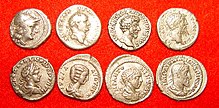
Back Denario AN ديناريوس Arabic Денарий Bulgarian Diner Breton Denari Catalan Denár Czech Denarius Danish Denar (Rom) German Δηνάριο Greek Denaro Esperanto
This article needs additional citations for verification. (July 2015) |


Second row (left to right): 199 AD Caracalla, 200 AD Julia Domna, 219 AD Elagabalus, 236 AD Maximinus Thrax
The denarius (Latin: [deːˈnaːriʊs]; pl.: dēnāriī, Latin: [deːˈnaːriiː]) was the standard Roman silver coin from its introduction in the Second Punic War c. 211 BC[1] to the reign of Gordian III (AD 238–244), when it was gradually replaced by the antoninianus. It continued to be minted in very small quantities, likely for ceremonial purposes, until and through the Tetrarchy (293–313).[2]: 87
The word dēnārius is derived from the Latin dēnī "containing ten", as its value was originally of 10 assēs.[note 1] The word for "money" descends from it in Italian (denaro), Slovene (denar), Portuguese (dinheiro), and Spanish (dinero). Its name also survives in the dinar currency.
Its symbol is represented in Unicode as 𐆖 (U+10196), a numeral monogram that appeared on the obverse in the Republican period, denoting the 10 asses ("X") to 1 denarius ("I") conversion rate. However it can also be represented as X̶ (capital letter X with combining long stroke overlay).
- ^ Crawford, Michael H. (1974). Roman Republican Coinage, Cambridge University Press, 2 Volumes. ISBN 0-521-07492-4
- ^ David. L. Vagi. Coinage and History of the Roman Empire, c. 82 BC–AD 480. Vol. II. Sydney, Ohio: Coin World.
Cite error: There are <ref group=note> tags on this page, but the references will not show without a {{reflist|group=note}} template (see the help page).